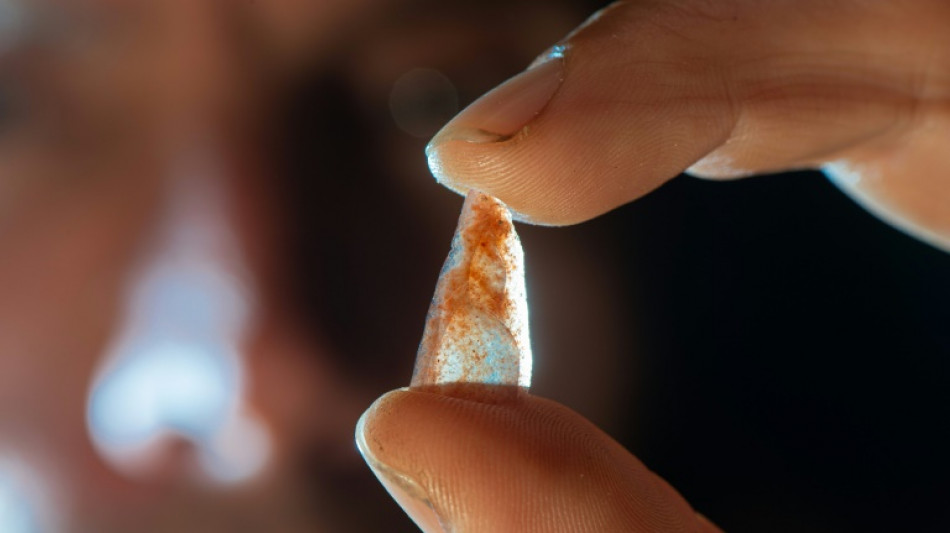
-
 Gabon early results show voters back new constitution
Gabon early results show voters back new constitution
-
Is AI's meteoric rise beginning to slow?

-
 Biden touts climate legacy in landmark Amazon visit
Biden touts climate legacy in landmark Amazon visit
-
Biden clears Ukraine for long-range missile strikes inside Russia

-
 'Nobody can reverse' US progress on clean energy: Biden
'Nobody can reverse' US progress on clean energy: Biden
-
Biden allows Ukraine to strike Russia with long-range missiles: US official

-
 Biden clears Ukraine for missile strikes inside Russia
Biden clears Ukraine for missile strikes inside Russia
-
Ukrainians brave arduous journeys to Russian-occupied homeland

-
 'Devil is in the details,' EU chief says of S.America trade deal
'Devil is in the details,' EU chief says of S.America trade deal
-
Toll in Tanzania building collapse rises to 13, survivors trapped

-
 'Red One' tops N.America box office but could end up in the red
'Red One' tops N.America box office but could end up in the red
-
Biden begins historic Amazon trip amid Trump climate fears

-
 Macron defends French farmers in talks with Argentina's Milei
Macron defends French farmers in talks with Argentina's Milei
-
India and Nigeria renew ties as Modi visits

-
 Typhoon Man-yi weakens as it crosses Philippines' main island
Typhoon Man-yi weakens as it crosses Philippines' main island
-
迪拜棕榈岛索菲特美憬阁酒店: 五星級健康綠洲

-
 The Retreat Palm Dubai MGallery by Sofitel: Пятизвездочный велнес-оазис
The Retreat Palm Dubai MGallery by Sofitel: Пятизвездочный велнес-оазис
-
The Retreat Palm Dubai MGallery by Sofitel: A five-star wellness Oasis

-
 Power cuts as Russian missiles pound Ukraine's energy grid
Power cuts as Russian missiles pound Ukraine's energy grid
-
Biden in historic Amazon trip as Trump return sparks climate fears

-
 India hails 'historic' hypersonic missile test flight
India hails 'historic' hypersonic missile test flight
-
Debt-saddled Laos struggles to tame rampant inflation

-
 India's vinyl revival finds its groove
India's vinyl revival finds its groove
-
Climate finance can be hard sell, says aide to banks and PMs

-
 Egypt's middle class cuts costs as IMF-backed reforms take hold
Egypt's middle class cuts costs as IMF-backed reforms take hold
-
Dinosaur skeleton fetches 6 million euros in Paris sale

-
 Trump's Republican allies tread lightly on Paris pact at COP29
Trump's Republican allies tread lightly on Paris pact at COP29
-
China's Xi urges APEC unity in face of 'protectionism'

-
 Farmers target PM Starmer in protest against new UK tax rules
Farmers target PM Starmer in protest against new UK tax rules
-
UN climate chief urges G20 to spur tense COP29 negotiations

-
 Philippines warns of 'potentially catastrophic' Super Typhoon Man-yi
Philippines warns of 'potentially catastrophic' Super Typhoon Man-yi
-
Tens of thousands flee as Super Typhoon Man-yi nears Philippines

-
 Gabon votes on new constitution hailed by junta as 'turning point'
Gabon votes on new constitution hailed by junta as 'turning point'
-
Tens of thousands flee as Typhoon Man-yi nears Philippines

-
 Is Argentina's Milei on brink of leaving Paris climate accord?
Is Argentina's Milei on brink of leaving Paris climate accord?
-
Fitch upgrades Argentina debt rating amid economic pain

-
 Trump picks Doug Burgum as energy czar in new administration
Trump picks Doug Burgum as energy czar in new administration
-
At summit under Trump shadow, Xi and Biden signal turbulence ahead

-
 Xi warns against 'protectionism' at APEC summit under Trump cloud
Xi warns against 'protectionism' at APEC summit under Trump cloud
-
Xi, Biden at Asia-Pacific summit under Trump trade war cloud

-
 Leftist voices seek to be heard at Rio's G20 summit
Leftist voices seek to be heard at Rio's G20 summit
-
Boeing strike will hurt Ethiopian Airlines growth: CEO

-
 US retail sales lose steam in October after hurricanes
US retail sales lose steam in October after hurricanes
-
Spate of child poisoning deaths sparks S.Africa xenophobia

-
 Comedian Conan O'Brien to host Oscars
Comedian Conan O'Brien to host Oscars
-
Gore says 'absurd' to hold UN climate talks in petrostates

-
 Global stocks struggle after Fed signals slower rate cuts
Global stocks struggle after Fed signals slower rate cuts
-
China tests building Moon base with lunar soil bricks

-
 Oil execs work COP29 as NGOs slam lobbyist presence
Oil execs work COP29 as NGOs slam lobbyist presence
-
Gore says climate progress 'won't slow much' because of Trump


Homo sapiens in Europe used bow-and-arrow 54,000 years ago: study
A cave in southern France has revealed evidence of the first use of bows and arrows in Europe by modern humans some 54,000 years ago, far earlier than previously known.
The research, published on Wednesday in the journal Science Advances, pushes back the age of archery in Europe by more than 40,000 years.
The use of the bow-and-arrow in Africa has been documented to date back some 70,000 years.
But the oldest previous evidence of archery in Europe was the discovery of bows and arrows in peat bogs of Northern Europe, notably Stellmoor in Germany, dating back 10,000 to 12,000 years.
The new research comes from the Mandrin rock shelter overlooking the middle valley of the Rhone River in southern France.
The Grotte Mandrin site, which was first excavated in 1990, includes layer upon layer of archaeological remains dating back over 80,000 years.
The researchers who conducted the latest study have documented previously that Neanderthals and their modern "cousins" -- Homo sapiens -- alternated in inhabiting the Mandrin cave.
A level known as the "Layer E" has been attributed to the presence of Homo sapiens some 54,000 years ago and is interposed between layers of numerous Neanderthal occupations.
The researchers conducted a functional analysis of flint artifacts found in Layer E that were more finely executed than the points and blades in the layers above and below.
Tiny flint points were the key because other elements of archery technology such as wood, fibers, leather, resins and sinew are perishable and rarely preserved in European Paleolithic sites.
- 'Too light to be efficient' -
For the study, the researchers reproduced the tiny flint points found in the cave, some of which are smaller than a US penny, and fired them as arrowheads with a replica bow at dead animals.
"We couldn't throw them at the animals any other way than with a bow because they were too tiny and too light to be efficient," said Laure Metz of Aix Marseille University, a co-author of the study along with Ludovic Slimak of the University of Toulouse.
"We had to use this kind of propulsion," Metz told AFP. "The only way that it was working was with a bow."
Fractures on the flint points were compared with scars found on the artifacts found in the cave, proving undoubtedly that they were used as arrowheads, the researchers said.
"Fractures for a lot of them, not all, were fractures of impact," Metz said. "And they are coming at the end of the point."
Metz said the evidence suggests that the Neanderthals and the Homo sapiens who used in the cave likely met at some point although "we don't know the nature of the meeting, whether it was nicely or not."
The Neanderthals who inhabited the Mandrin site continued to use traditional weapons, however, such as thrusted or hand-thrown spears and did not develop mechanically propelled weapons, she said.
"The traditions and technologies mastered by these two populations were thus profoundly distinct, illustrating a remarkable objective technological advantage to modern populations during their expansion into the European continent," the researchers said.
Metz said the occupants of the cave would have typically hunted horses, bison and deer and animal bones have been found inside.
H.Müller--CPN


